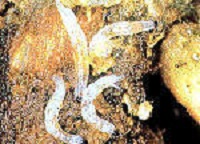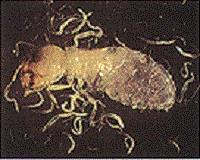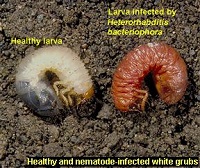
Exhibition time: 17-19 March, 2026 Shanghai, China
 中文
中文

Exhibition time: 17-19 March, 2026 Shanghai, China
 中文
中文

Biological Control Of Pest Insects With Nematodes.
Beneficial nematodes are becoming much more popular for soil pest control. These microscopic, beneficial nematodes actively hunt, penetrate and destroy over 200 pests from up to 100 insect families. These pests are ones that either directly injure our desired lawn or plants, or immature grub stages of insects before they mature to adults that cause damage. Being natural, beneficial nematodes are safe to use around humans, children and pets. They won’t harm non-target organisms such as bees, or pollinators. These beneficial nematodes attack the larval stages of soil-dwelling pests, leaving the plants alone. The parasitic nematodes enter their prey through body openings and release bacteria that kills their host within 48 hours. The nematodes can then reproduce inside the pest. Nematodes are recommended for use whenever pest insects are present.
Beneficial Nematodes naturally occur in soil and are used to control soil pest insects and whenever larvae or grubs are present. Like all of our products, it will not expose humans or animals to any health or environmental risks. Beneficial nematodes only attack soil dwelling insects and leave plants and earthworms alone. The beneficial nematodes enters the larva via mouth, anus or respiratory openings and starts to feed. This causes specific bacteria to emerge from the intestinal tract of the nematode. These spread inside the insect and multiply very rapidly. The bacteria convert host tissue into products which can easily be taken up by the nematodes. The soil dwelling insect dies within a few days. Beneficial nematodes are a totally safe biological control in pest insects. The Beneficial nematodes are so safe the EPA has waived the registration requirements for application.
NATURE'S BEST WAY OF KILLING Grubs and Japanese Beetles.
Though they are harmless to humans, animals, plants, and healthy earthworms, beneficial nematodes aggressively pursue insects. The beneficial nematodes can be used to control a broad range of soil inhabiting insects and above ground insects in their soil inhabiting stage of life. More than 200 species of pest insects from 100 insect families are susceptible to these nematodes. When they sense the temperature and carbon dioxide emissions of soil-borne insects, beneficial nematodes move toward their prey and enter the pest through its body openings. The nematodes carry an associated bacterium (Xenorhabdus species) that kills insects fast within 48 hours. The bacteria is harmless to humans and other organisms and cannot live freely in nature. Several generations of nematodes may live and breed within the dead insect, feeding on it as a food source. When the food source is gone, they migrate into the soil in search of a new host. When the pest population is eliminated, the beneficial nematodes die off and biodegrade. Beneficial nematodes are so effective, they can work in the soil to kill the immature stages of garden pests before they become adults.

Beneficial nematodes infest grubs and other pest insects that are known to destroy lawns and plants.
The Nematodes are effective against grubs and the larval or grub stage of Japanese Beetles, Northern Masked Chafer, European Chafer, Rose Chafer, Fly larvae, Oriental Beetles, June Beetles, Flea beetles, Bill-bugs, Cut-worms, Army worms, Black Vine Weevils, Strawberry Root Weevils, Fungus Gnats, Sciarid larvae, Sod Web-worms, Girdler, Citrus Weevils, Maggots and other Dip-tera, Mole Crickets, Iris Borer, Root Maggot, Cabbage Root Maggot and Carrot Weevils.
Beneficial nematodes belong to one of two genera: Steinernema and Heterorhabditis are commercially available in the U.S. Steinernema is the most widely studied beneficial nematode because it is easy to produce. Heterorhabditis is more difficult to produce but can be more effective against certain insects, such as the white grubs, and Japanese beetles.
How beneficial nematodes work: The life cycle of beneficial nematodes consists of six distinct stages: an egg stage, four juvenile stages and the adult stage. The adult spends its life inside the host insect. The third juvenile stage, called a dauer, enters the bodies of insects (usually the soil dwelling larval form. Some nematodes seek out their hosts, while others wait for the insect to come to them. Host seeking nematodes travel through the soil the thin film of water that coats soil particles. They search for insect larvae using built-in homing mechanisms that respond to changes in carbon dioxide levels and temperature. They also follow trails of insect excrement. After a single nematode finds and enters an insect through its skin or natural openings, the nematode release a toxic bacteria that kills its host, usually within a day or two. In less than two weeks the nematodes pass through several generations of adults, which literally fill the insect cadaver. Steinernema reproduction requires at least two dauer nematodes to enter an insect, but a single Heterorhabditis can generate offspring on its own. The nematodes actively searches for insect larvae. Once inside the larva the nematodes excretes specific bacteria from its digestive trac before it starts to feed. The bacteria multiply very rapid and convert the host tissue into products that the nematodes take up and use for food. The larva dies within a few days and the color changes from white-beige to orange-red or red-brown. The nematodes multiply and develop within the dead insect. As soon as the nematodes are in the infectious third stage, they leave the old host and start searching for new larvae. Infected grubs turn color from white-beige to red brown 2-4 days after application and becomes slimy. After a few weeks, dead larvae disintegrate completely and are difficult to find.
Beneficial nematodes are also very effective against termites, German cockroaches, flies, ant, and fleas.


APPLICATION:
Beneficial Nematodes are very easy to use. Mix with water and spray or sprinkle on the soil along garden plants or lawn. Put the contents of the Beneficial nematodes in a bucket of water and stir to break up any lumps, and let the entire solution soak for a few minutes. Application can be made using a water-can, irrigation system, knapsack or sprayer. On sprayer use a maximum pressure to avoid blockage, all sieves should be removed. The sprayer nozzle opening should be at least 1/2 mm. Evenly spread the spraying solutions over the ground area to be treated. Continuous mixing should take place to prevent the nematodes from sinking to the bottom. After application keep the soil moist during the first two weeks for the nematodes to get establish. For a small garden the best method is using a simple sprinkling or water can to apply the Beneficial nematodes to the soil. Apply nematodes before setting out transplants; for other pest insects, Japanese Beetles and grubs, apply whenever symptomatic damage from insects is detected. Best to apply water first if soil is dry.Application and amount for 50 and 100 Mil. Nematodes. The 50 Mil. + nematodes are packed in an inert carrying material that will dissolve in water when mixed. You can use a watering can, pump sprayer; hose end sprayer and irrigation system, backpack sprayers, or motorized sprayer. The 10 Mil. 50 Mil. and 100 Mil. Nematodes mix 1 teaspoon per gallon of water. The Large yard size: 1/2 Acre Size (50 Million) you can use up to 40 Gallons of water The Acre size 100 Mil. Nematodes you can use up to 100 Gallons of water. Evenly spread the solution over the ground areas to be treated. Continuous mixing should take place to prevent the nematodes from sinking to the bottom of the container. To avoid blockages, remove all filters from the sprayer. You can sprinkle the soil with water again after application to move the nematodes into the soil. Apply nematodes as soon as possible for best product performance. Keep the soil most for the first week after application.
Proper storage and handling is essential to nematode health.
Always follow the package instructions for the best method of mixing nematodes. Formulations vary depending on the species and target insect. Nematodes can be stored in the refrigerator up to a month (not the freezer) before they are mixed with water, but once the nematodes are diluted in water, they cannot be stored. Also, nematodes shouldn’t be stored in hot vehicles, or left in spray tanks for long periods of time.
Nematodes need moisture in the soil for movement (if the soil is too dry or compact, they may not able to search out hosts) and high humidity if they are used against foliage pests. Watering the insect-infested area before and after applying nematodes keeps the soil moist and helps move them deeper into the soil. Care should be taken not to soak the area because nematodes in too much water cannot infect.
From Buglogical Control Systems, Inc.

Previous: Rural residents harvesting prosperous future
Next: Role of Soil Fungus